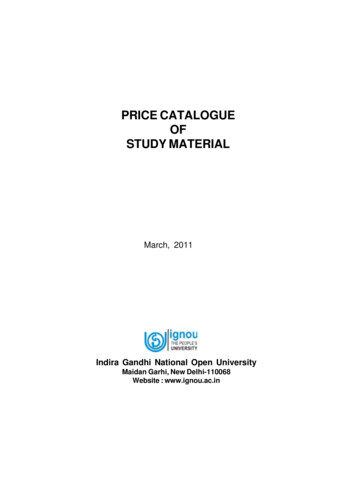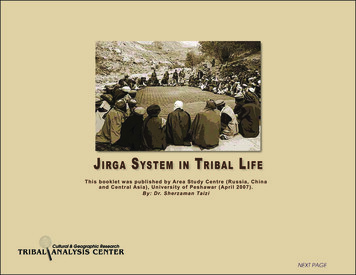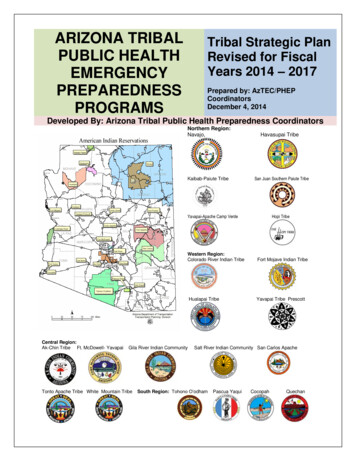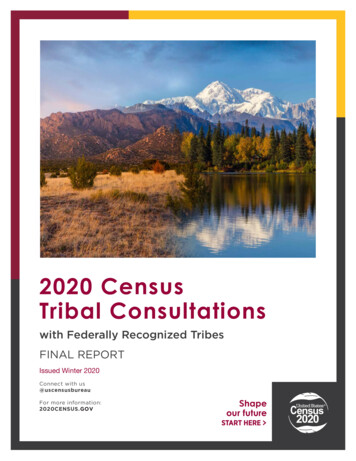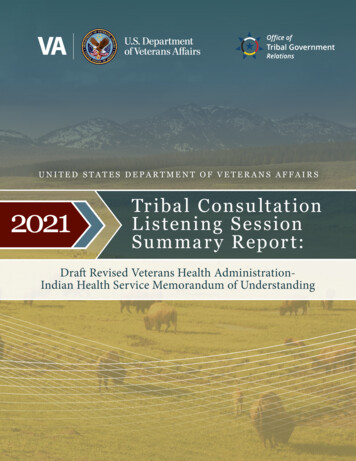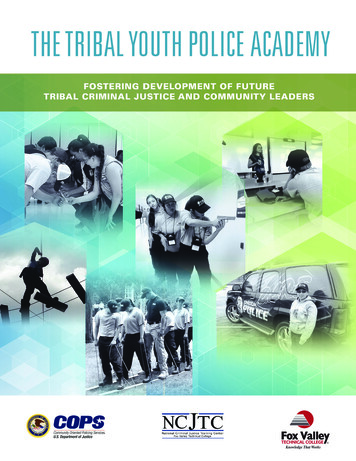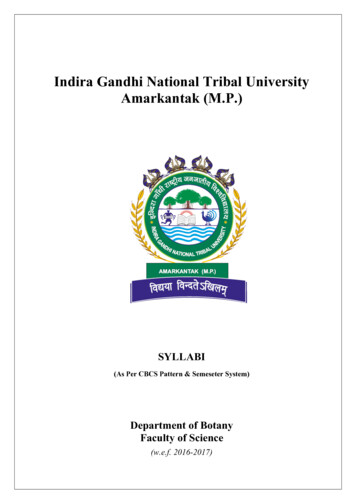
Transcription
Indira Gandhi National Tribal UniversityAmarkantak (M.P.)SYLLABI(As Per CBCS Pattern & Semeseter System)Department of BotanyFaculty of Science(w.e.f. 2016-2017)
IGNTU, Amarkantak offers under-graduate (UG) and post-graduate (PG) Botanycourses with an intake capacity of 30 and 20 students, respectively. Courses arestructured in a way to promote an all-encompassing study of plants, including microbes.The complete curriculum, including UG and PG, consists of classical studies rangingfrom morphology to taxonomy; specialized knowledge such ecology, physiology,biochemistry to molecular biology. Besides their ecological significances, thebiotechnological applications of plants as well as their potential use in promotingentrepreneurship amongst students have also been highlighted. We hope that theprogramme will open up a range of career opportunities for students.Objectives of the programme:Upon completion of the course candidates shall have achieved the following objectives:1. A detailed knowledge of structure, function and application of plants andmicroorganisms.2. Facilitate the applications of plants in industry, academics as well as inenvironmental protection.3. Help in understanding the current trends in plant science research.4. Promote an ability to design, undertake and interpret a research projects.5. Laboratory experiments will help in skills development amongst students.Salient Features:1.2.3.4.Tribal-centric syllabusIn-depth interactive lecturesState of the art lab exercisesEnhance writing & presentation skill
Indira Gandhi National Tribal UniversityAmarkantak (M.P.)SYLLABIDepartment of BotanyFaculty of ScienceB. Sc. (Hon’s.) Programme in Botany(As Per CBCS Pattern & Semester System; w.e.f. 2016-2017)
Course Layout:Semester CORE COURSE(No of papers -14; Each with06 credits, including 04 fortheory & 02 for practicals)AbilityEnhancementCourse (AEC)SkillEnhancementCourse (SEC)DisciplineGenericSpecificElective (GE)Elective (DSE) (No. of papers –(4 credits each)(No. of papers: 02;Each with 04credits, including02 for theory & 02for practicals)(No. of papers: 02;Each with 06credits, including04 for theory & 02for practicals)CompulsoryIBBT01: Microbiology &AlgaeBBP01: PracticalsEnglishCommunicationGBBT01:Plant Diversity(Algae ntalStudiesGBBT02:Biology ofAngiosperms(Morphology,anatomy &embryology)GBBP02:Practicals/TutorialGBBT03:Plant Physiology &MetabolismGBBP03:Practicals/TutorialBBT02: Biomolecules &Cell BiologyBBP02: PracticalsIIBBT03: Fungi & PlantPathologyBBP03: PracticalsBBT04: Archegoniate &PaleobotanyBBP04: PracticalsIIIBBT05: Morphology &Anatomy of AngiospermsBBP05: Practicals04; Each with 06credits, including04 for theory & 02for P02BBT06: Economic BotanyBBP06: PracticalsBBT07: Genetics, PlantBreeding & EvolutionBBP07: PracticalsIVBBT08: Molecular BiologyBBP08: PracticalsBBT09: Plant Ecology &PhytogeographyBBP09: 04GBBT04:Plant Taxonomy &EcologyGBBP04:Practicals/TutorialBBT10: Taxonomy ofAngiospermsBBT10: PracticalsVBBT11: ReproductiveBiology of AngiospermsBBP11: PracticalsDBBT01:AnalyticalTechniques inPlant Science
DBBP01:PracticalsVIBBT12: Plant PhysiologyBBP12: T13: Plant MetabolismBBP13: T04:Project WorkBBT14: PlantBiotechnologyBBP14:PracticalsTotal Credits: 06 x14 84Grand Total: 148 credits02 x 04 0802 x 04 0804 x 06 2404 x 06 24
Core Courses (Compulsory)BBT1: Algae & MicrobiologyBBT2: Biomolecules & Cell BiologyBBT3: Mycology & Plant PathologyBBT4: Archegoniate & PaleobotanyBBT5: Morphology & Anatomy of AngiospermsBBT6: Economic BotanyBBT7: Genetics, Plant Breeding & EvolutionBBT8: Molecular BiologyBBT9: Plant Ecology & PhytogeographyBBT10: Plant SystematicsBBT11: Reproductive Biology of AngiospermsBBT12: Plant PhysiologyBBT13: Plant MetabolismBBT14: Plant Biotechnology(Respective practicals from BBP01-BBP14)Skill Enhancement Courses rsHerbal TechnologyFloricultureMushroom Culture TechnologyDiscipline Specific Electives (DSE)DBBT01:DBBT02:DBBT03:DBBT04:Analytical Techniques in Plant ScienceBioinformaticsBiostatisticsProject WorkGeneric Electives (GE)GBBT01: Plant Diversity (Algae to Archegoniate)GBBT02: Biology of Angiosperms (Morphology, Anatomy & Embryology)GBBT03: Plant Physiology & MetabolismGBBT04: Plant Taxonomy & Ecology
Core Courses (CC1-CC14)(Compulsory)7
Semester-IBBT01: Microbiology & AlgaeTHEORY(Credits 04; contact hours – 60h; maximum marks -100)Unit I (6h)History and scope of microbiology; A brief account of archaea and wall less forms (Mycoplasma andSpheroplasts).Unit II (18h)Bacteria: Structure of a bacterial cell - capsule and slime, flagella, cell wall, cell membrane, geneticmaterial, plasmid and endospore; nutrition and reproduction-vegetative, asexual and geneticrecombination (transformation, conjugation and transduction); Culture and growth; Agricultural andindustrial importance.Unit III (12h)Viruses: Discovery, physiochemical and biological characteristics; Structures of Prions, Viroids,bacteriophages (Lysogenic and lytic cycles) and RNA virus (TMV); Importance in vaccine productionand in research.Unit IV (10h)Algae: General introduction, classification range of vegetative structure, reproduction, ecology andeconomic importance, Role in the environment, agriculture and industry.Unit V (14h)Prochlorophyta: Structure and evolutionary significanceReproduction and life cycle of the following genera:Cyanophyceac: Oscillatoria, Nostoc, ScytonemaChlorophyceae: Volvox; OedogoniumPhaeophyceae: EctocarpusRhodophyceae: PolysiphoniaSuggested Readings1.2.3.4.5.6.7.8.9.Elements of Microbiology, Michael J Pelczar, 5th Ed, Tata McGraw HillPrescott's Microbiology, Joanne Willey, Linda Sherwood, Chris Woolverton, 8th edn, Tata McGraw Hill.Brock’s Biology of Microoranisms, Madigan MT, Martinko JM, Dunlap PV, Clark DP, (2012), 13th edition,Pearson Education Inc.General Microbiology, Stainier RY, Ingraham JL, Wheelis ML, Painter PR, (2009), 5th edition, McMillan PressLtd., Hound MillsFoundation in Microbiology, Talaro KP, Chess B, (2011), 8th edition, McGraw-HillA Text Book of Botany, Authors - Singh, Pandey and Jain, Rastogi Publication, Meerut (A combined book forAlgae, Fungi, Brophyta & Pteridophyta)College Botany, Gangulee HC, Kar AK, Vol. II- 2011, New Central Book Agency, Kolkata (A combined book forAlgae, Fungi, Brophyta & Pteridophyta)Phycology, Lee RE, 2008, Cambridge University Press, CambridgeAlgae, BR Vashista, S Chand Publication, New Delhi8
BBP01: Practicals (credits – 02; contact hours – 60h; maximum marks - 50)1. Electron micrographs/models of viruses – T-Phage and TMV; Line drawings/photographs ofLytic and Lysogenic Cycles.2. Types of Bacteria to be observed from temporary/permanent slides/photographs; Electronmicrographs of binary fission, endospore, conjugation, cross sections of root nodules.3. Gram staining4. Endospore (from soil bacteria) staining with malachite green using the5. Study of vegetative and reproductive structures of Nostoc, Volvox, Oedogonium, Chara,Vaucheria, Ectocarpus, Polysiphonia through temporary preparations and permanent slides.9
BBT02: Biomolecules & Cell BiologyTHEORY(Credits – 4; contact hours – 60h; maximum marks - 100)Unit I (16h)Biomolecules: Carbohydrates: Nomenclature and classification;Lipids: Definition and major classes of storage and structural lipids;Proteins: Structure of amino acids; Levels of protein structure-primary, secondary, tertiary andquaternary structures;Nucleic acids: Structure of nitrogenous bases; Structure and function of nucleotides.Unit II (8h)Enzymes: Structure of enzyme: holoenzyme, apoenzyme, cofactors, coenzymes and prosthetic group;Classification of enzymes; Features of active site, substrate specificity, mechanism of action (activationenergy, lock and key hypothesis, induced - fit theory), Michaelis – Menten equation, enzyme inhibitionand factors affecting enzyme activity.Unit III (16h)The Cell: Ultrastructure of plant cell, structure and function of plant cell wall, chemical composition ofmembranes, fluid mosaic model, membrane transport – Passive, active and facilitated transport,endocytosis and exocytosis.Unit IV (12h)Cell Organelles: Structural organization and functions of - Nucleus, Cytoskeleton: Chloroplast,Mitochondria, Peroxisomes, Endoplasmic Reticulum, Golgi apparatus, LysosomesUnit V (8h)Cell Division: Phases of eukaryotic cell cycle, mitosis and meiosisSuggested Readings1.2.3.Campbell, MK (2012) Biochemistry, 7th ed., Published by Cengage LearningTymoczko JL, Berg JM and Stryer L (2012) Biochemistry: A short course, 2nd ed., W.H. FreemanHardin, J., Becker, G., Skliensmith, L.J. (2012). Becker’s World of the Cell, Pearson Education Inc. U.S.A. 8thedition.4. Berg JM, Tymoczko JL and Stryer L (2011) Biochemistry, W.H. Freeman and Company5. Karp G (2010). Cell Biology, John Wiley & Sons, U.S.A. 6th edition.6. Cooper GM, Hausman RE (2009) The Cell: A Molecular Approach. 5th edition. ASM Press & Sunderland,Washington, D.C.; Sinauer Associates, MA.7. Becker WM, Kleinsmith LJ, Hardin J, Bertoni GP (2009) The World of the Cell. 7th edition. Pearson BenjaminCummings Publishing, San Francisco8. Nelson DL, Cox MM (2008) Lehninger Principles of Biochemistry, 5th Edition., W.H. Freeman and Company.9. Cell and Molecular Biology, Robertis EDP De & Robertis EMF De, Walters Kluwer (India) Pvt. Ltd10. A Text Book of Cytology, Genetics and Evolution, Gupta, PK, Rastogi Publication, Meerut10
BBP02: Practicals (credits -02; contact hours – 60h; maximum marks - 50)1.2.3.4.5.6.Qualitative tests for carbohydrates, reducing sugars, non-reducing sugars, lipids and proteins.Study of plant cell structure with the help of epidermal peel mount of Onion/Rhoeo/Crinum.Demonstration of the phenomenon of protoplasmic streaming in Hydrilla leaf.Measurement of cell size by the technique of micrometry.Counting the cells per unit volume with the help of haemocytometer (Yeast/pollen grains).Cytochemical staining of DNA (Feulgen), and cell wall from the epidermal peel of onionusing Periodic Schiff’s (PAS) staining techniques.7. Study the phenomenon of plasmolysis and deplasmolysis.8. Study different stages of mitosis9. Study of different stages of meiosis.11
Semester-IIBBT03: Fungi & Plant PathologyTHEORY(Credits – 4; contact hours -60h; maximum marks - 100)Unit I (10h)Fungi: Introduction; General characteristics; classification, range of thallus organization; cell wallcomposition; nutritionUnit II (16h)The life histories of the following genera:Mastigomycotina: AlbugoZygomycotina: MucorAscomycotina: PezizaBasidiomycotina: Agaricus, PucciniaDeuteromycotina: CercosporaUnit III: Symbiotic Associations (8h)Lichen: Occurrence; General characteristics; Growth forms and range of thallus organization; Natureof associations of algal and fungal partners; Reproduction;Mycorrhiza: Ectomycorrhiza, Endomycorrhiza and their significance.Unit IV: Plant Pathology (10h)Terms and concepts; General symptoms; Etiology; Symptomology; Host-Pathogen relationships;prevention and control of plant diseases.Unit V: Plant Diseases (16h)Causal organism, symptoms, disease cycle and control measures of the following plant diseases: (LateBlight of Potato, White Rust of Crucifers, Black Rust of Wheat, Tikka disease of Groundnut, CitrusCanker, Yellow Vein Mosaic of Bhindi)1.2.3.4.5.6.7.Suggested ReadingsIntroductory Mycology, Alexopoulos CJ, Mims CW, Blackwell M (1996), John Wiley & Sons (Asia) Singapore.4th edition.Introduction to Fungi, Webster J & Weber R (2007), Cambridge University Press, Cambridge. 3rd edition.Text Book of Fungi and Their Allies, Sethi IK & Walia SK (2011), Macmillan Publishers India Ltd.Fungi & Plant Diseases: MundukarPlant Pathology, Agrios GN (1997), 4th edition, Academic Press, U.K.Plant Pathology, Sharma PD (2011), Rastogi Publication, Meerut, India.Plant Pathology and Plant Pathogens, Lucas JA (1998), Wiley-Blackwell, CRC Press12
BBP03: Practicals (credits – 02; contact hours -60h; maximum marks - 50)1. Rhizopus/Mucor: study of asexual stage from temporary mounts and sexual structures throughpermanent slides.2. Aspergillus and Penicillium: study of asexual stage from temporary mounts and sexual stage throughpermanent slides/photographs.3. Alternaria: Specimens/photographs and temporary mounts.4. Puccinia: Herbarium specimens of Black Stem Rust of Wheat and infected Barberry leaves;sections/ mounts of spores on wheat and permanent slides of both the hosts.5. Agaricus: Specimens of button stage and full grown mushroom; sectioning of gills of Agaricus, fairyrings and bioluminescent mushrooms to be shown.6. Albugo: Study of symptoms of plants infected with Albugo; asexual phase study through section/temporary mounts and sexual structures through permanent slides.7. Lichens: Study of growth forms of lichens (crustose, foliose and fruticose) on different substrates.Study of thallus and reproductive structures (soredia and apothecium) through permanent slides.Mycorrhizae: ectomycorrhiza and endomycorrhiza (Photographs)8. Herbarium specimens of - bacterial diseases (Citrus canker), Viral diseases (TMV, Vein clearing),Fungal diseases (Early blight of potato, Black stem rust of wheat and White rust of crucifers).13
BBT04: Archegoniate & PaleobotanyTHEORY(Credits - 4, contact hours 60h; maximum marks - 100)Unit I (4h)Introduction: Unifying features of archegoniates; Transition to land habit; Alternation ofgenerations.Unit II: Bryophyta (16h)A general account of bryophytes including their classification, evolution of sporophytes, economicimportance of bryophytes. Study of the life histories of the following representative generaHepaticopsida – Riccia, MarchantiaAnthocerotopsida – AnthocerosBryopsida – Sphagnum, FunariaUnit III: Pteridophyta (20h)General account and classification of Pteridophytes, their distribution in India, Stelar system and itsevolution in Pteridophytes; Life history of the following genera - Rhynia (Psilophyta), Lycopodium,Selaginella (Lycophyta), Equisetum (Athrophyta), Marsilea, Adiantum, Dryopteris (Filicophyta)Unit IV: Gymnosperms (12h)General accounts, distribution and classificationLife history of the following genera – Cycas, Pinus, Gingo, and GnetumUnit V: Paleobotany (08h)Elementary knowledge of paleobotany, geological era, processes of fossilization, Living fossils,types of fossils, form genera and reconstruction of fossil plantsSuggested ReadingsBryophyta, PC Vahishta, S. Chand Publication, New Delhi.Introduction to Bryophytes, Vander-Poorteri & Goffinet B (2009), Cambridge University PressAn introduction to Embryophyta (Vol. I): Bryophyta. Parihar NS (1991), Central Book Depot, AllahabadBryophyta, Watson GDAn Introduction to Pteridopyta, Rashid A, 2nd edition, 2011 (Reprint), Vikas Publishing House Pvt. Ltd.,Noida6. The Biology and Morphology of Pteridophytes, NS Parihar (1996), Central Book Depot, Allahabad7. Pteridophyta, Vashistha PC, Sinha AK, Kumar A (2010), S. Chand. Delhi, India8. Morphology of Gymnosperms, Sporne KR, B.I. Publication, New Delhi9. Gymnosperms. Bhatnagar SP, Moitra A (1996). New Age International (P) Ltd Publishers, New Delhi, India10. Morphology of Gymnosperms. JM Coulter, CJ Chamberlain (1977), University of Chicago Press.1.2.3.4.5.14
BBP04: Practicals (credits – 02; contact hours – 60; maximum marks – 50)Bryophytes:1. Riccia: Morphology of thallus2. Marchantia: Morphology of thallus, whole mount of rhizoids & scales, vertical section ofthallus through Gemma cup, whole mount of Gemmae (all temporary slides), vertical section ofAntheridiophore, Archegoniophore, longitudinal section of Sporophyte (all permanent slides)3. Anthoceros: Morphology of thallus, dissection of sporophyte (to show stomata, spores,pseudoelaters, columella) (temporary slide), vertical section of thallus (permanent slide)4. Sphagnum: Morphology of plant, whole mount of leaf (permanent slide only).Pteridophytes:1. Marsilea, Adiantum, Dryopteris: Morphology, whole mount of leaf with ligule, transversesection of stem, whole mount of strobilus, whole mount of microsporophyll andmegasporophyll (temporary slides), rhizophore, longitudinal section of strobilus (permanentslide)2. Equisetum- Morphology, transverse section of internode, longitudinal section of strobilus,transverse section of strobilus, whole mount of sporangiophore, whole mount of spores (wetand dry) (temporary slide), transverse section of rhizome (permanent slide).Gymnosperm:3. Cycas: Morphology (coralloid roots, bulbil, leaf), whole mount of microsporophyll, transversesection of coralloid root, transverse section of rachis, vertical section of leaflet, vertical sectionof microsporophyll, whole mount of spores (temporary slides), longitudinal section of ovule,transverse section of root (permanent slide)4. Pinus: Morphology (long and dwarf shoots, whole mount of dwarf shoot, male and femalecones), transverse section of Needle, transverse section of stem, longitudinal section of /transverse section of male cone, whole mount of microsporophyll, whole mount of microspores(temporary slides), longitudinal section of female cone, tangential longitudinal section & radiallongitudinal sections stem (permanent slide)Paleobotany:Fieldwork and collection/observation of fossils.15
Semester-IIIBBT05: Morphology & Anatomy of AngiospermsTHEORY(Credits – 4; contact hours – 60h; maximum marks - 100)Unit I (4h)Morphology: Broad outlines of vegetative parts (root, stem, leaf) and their modifications, anatomicalarrangement of reproductive structures.Unit II (12h)Tissues: classification of tissues; simple and complex tissues, organogenesis during embryogenicdevelopment, Pits and plasmodesmata, hydathodes and laticifers.Unit III (18h)Apical meristems: Evolution of the concept of organization of shoot apex (Apical cell theory,Histogen theory, Tunica Corpus theory; Types of vascular bundles; Structure of dicot and monocotstem. Structure of dicot and monocot leaf. Organization of root apex (Apical cell theory, Histogentheory, Korper-Kappe theory); Quiescent centre; Root cap; Structure of dicot and monocot root;Endodermis, exodermisUnit IV (16h)Vascular Cambium and Wood: Structure and function of cambium; Secondary growth in root andstem; sapwood and heartwood; early and late wood, tyloses; dendrochronology, lenticels,mechanical tissues, anomalous secondary growth.Unit V (10h)Adaptive and Protective Systems: Epidermal tissue system, cuticle, epicuticular waxes, trichomes(uni-and multicellular, glandular and nonglandular, two examples of each), stomata (classification);Anatomical adaptations of xerophytes and hydrophytes.Suggested Readings1. Dickison WC (2000) Integrative Plant Anatomy, Harcourt Academic Press, USA.2. Fahn A (1974) Plant Anatomy, Pergmon Press, USA.3. Mauseth JD (1988) Plant Anatomy. The Benjammin/Cummings Publisher, USA.4. Evert RF (2006) Esau’s Plant Anatomy: Meristems, Cells, and Tissues of the Plant Body: Their Structure, Functionand Development, John Wiley and Sons, Inc.16
BBP05: Practicals (credits – 02; contact hours – 60h; maximum marks – 50)1. Study of anatomical details with the help of suitable examples through permanent slides/temporarystain mounts/ macerations/museum specimens.2. Study of Apical meristem of root, shoot and vascular cambium.3. Study of distribution and types of parenchyma, collenchyma and sclerenchyma.4. Study of xylem tracheary elements-tracheids, vessel elements; thickenings; perforation plates;xylem fibres.5. Study of phloem sieve tubes-sieve plates; companion cells; phloem fibres.6. Study of epidermal system: cell types, stomata types; trichomes: non-glandular and glandular.7. Study of root: monocot, dicot, secondary growth.8. Study of stem: monocot, dicot - primary and secondary growth; periderm; lenticels.9. Study of leaf: isobilateral, dorsiventral10. Study of adaptive anatomy: xerophytes, hydrophytes.17
BBT06: Economic BotanyTHEORY(Credits – 4; contact hours – 60h; maximum marks - 100)Unit I: Origin of Cultivated Plants (16h)The concept of Centres of Origin, their importance with reference to Vavilov’s work; Examplesof major plant introductions; Crop domestication and loss of genetic diversity; Evolution of newcrops/varieties; Importance of germplasm diversity.Unit II: Cereals & Legumes (12h)Wheat and Rice (origin, morphology, processing & uses); Brief account of millets; Origin,morphology and uses of Chick pea, Pigeon pea and fodder legumes.Unit III: Sugars & Spices (12h)Morphology and processing of sugarcane, products and by-products of sugarcane industry;Important spices (botanical name, their family and part used), economic importance of fennel,saffron, clove and black pepper.Unit IV Beverages & Edible and Essential Oils (10h)Tea, Coffee (morphology, processing & uses); General description, extraction and healthimplications of groundnut, soybean; Essential Oils: General account, extraction methods.Unit V: Medicinal, Timber & Fiber Yielding Plants (10h)Medicinally important plants of Central India (botanical name, family, plant parts used); Generalaccount of teak and sal; morphology, cultivation and uses of cotton, and jute.Suggested Readings1. Kochhar SL (2012) Economic Botany in Tropics, MacMillan & Co. New Delhi, India.2. Wickens GE (2001) Economic Botany: Principles & Practices. Kluwer Academic Publishers, The Netherlands.3. Chrispeels MJ, Sadava DE (1994) Plants, Genes and Agriculture. Jones & Bartlet Publishers.18
BBP06: Practicals (credits – 02; contact hours – 6-h; maximum marks – 50)1. Cereals: Wheat (habit sketch, LS/TS of grain)Rice (habit sketch, study of paddy and grain.2. Legumes: Soybean, Groundnut, (habit, fruit, seed structure).3. Sources of sugars and starches: Sugarcane (habit sketch; cane juice,4. Spices: Black pepper, Fennel and Clove (habit and sections).5. Beverages: Tea (plant specimen, tea leaves), Coffee (plant specimen, beans).6. Different sources of oils and fats7. Fiber-yielding plants: Cotton (specimen, whole mount of seed to show lint and fuzz; wholemount of fiber and test for cellulose), Jute (specimen, transverse section of stem, test for lignin).19
BBT07: Genetics, Plant breeding & EvolutionTHEORY(Credits – 4; contact hours – 60h; maximum marks - 100)Unit I: Mendelian Genetics & Its Extension (16h)Mendelism: History; Principles of inheritance; Chromosome theory of inheritance; Autosomesand sex chromosomes; Incomplete dominance and co-dominance; Multiple alleles, Lethalalleles, Epistasis, Pleiotropy, Recessive and Dominant traits, Numericals; Polygenicinheritance.Unit II: (16 lectures)Linkage and crossing over, cytological basis of crossing over; Recombination frequency, two- and three-factor crosses, Interference and coincidence, Sex Linked inheritance.Numerical and structural changes in chromosomes: Deletion, Duplication, Inversion,Translocation, Position effect, Euploidy and AneuploidyUnit III: Gene Mutations (10h)Types of mutations; Molecular basis of Mutations; Mutagens - physical and chemical; Role ofTransposons.Unit IV: Plant Breeding (10h)Objectives of plant breeding, selection of self and cross-pollinated plants, hybridization, anthesis,self-sterility, male sterile lines, single, double and multiple crosses.Unit V: Organic Evolution (8h)Inheritance of acquired characters (Lamarckism), natural selection (Darwinism), de Vriesmutation theory, synthetic theory.Suggested Readings1.2.3.4.5.6.7.8.9.A Text Book of Cytology, Genetics and Evolution, Gupta, PK, Rastogi Publication, MeerutPrinciples of Genetics, Gardner EJ, Simmons MJ, Snustad DP (2010), John Wiley & Son, India, 5th ednGenetics: Classical to Modern, Gupta PK (2007), Rastogi Publication, MeerutPrinciples of Genetics, Snustad DP, Simmons MJ, (2010), 5th edition, John Wiley & Sons Inc., India.Concepts of Genetics, Klug WS, Cummings MR, Spencer CA, (2012), 10th edition, Benjamin Cummings, USA.Introduction to Genetic Analysis, Griffiths AJF, Wessler SR, Carroll SB, Doebley J, (2010), 10th edition, W.H.Freeman and Co., USA.Variation and Evolution in Plants, Stebbins GL,Griffiths AJF, Wessler SR, Carroll SB, Doebley J (2010) Introduction to Genetic Analysis, WH Freeman & Co,thUSA, 10 edition.Plant Breeding, BD Singh (1994), Kalyani Publications, New Delhi.20
BBP07: Practicals (credits – 02; contact hours – 60h; maximaum marks - 50)1.2.3.4.Study of Mendel’s laws through seed ratios.Laboratory exercises in probability and chi-square.Pedigree analysis for dominant and recessive autosomal and sex linked traits.Incomplete dominance and gene interaction through seed ratios (9:7, 9:6:1, 13:3, 15:1, 12:3:1,9:3:4).5. Photographs/Permanent slides showing Translocation Ring, Laggards and Inversion Bridge.21
Semester-IVBBT08: Molecular BiologyTHEORY(Credits – 4; contact hours – 60h; maximum marks - 100)Unit I (4h)Historical perspective; DNA as the carrier of genetic information (Griffith’s, Hershey & Chase,Avery, McLeod & McCarty, Fraenkel-Conrat’s experiments).Unit II: The Structures of DNA & RNA (20h)DNA Structure, forms of DNA, Organization of DNA in Prokaryotes and eukaryotes; RNAStructures (mRNA, rRNA, t-RNA) and functions, secondary and tertiary structure;Chromatin structure- Euchromatin, HeterochromatinUnit III: The Replication of DNA (8h)General principles - bidirectional, semi-conservative and semi-discontinuous replication. Replicationin prokaryotes and eukaryotes.Unit IV: Transcription & Modification of RNA (16h)Concept of Central Dogma: Basic concepts of transcription in prokaryotes and eukaryotes. Principlesof transcriptional regulation; Prokaryotes: Regulation of lactose metabolism and tryptophansynthesis in E. coli; Eukaryotes: transcription factors; Split genes, introns and exons, mRNAtransport.Unit V: Translation (12h)Genetic code, Ribosome structure and assembly, a m i n o a c y l a t i o n , tRNA synthetases,charging of tRNA; Translation in prokaryotes and eukaryotes; Inhibitors of protein synthesis; Posttranslational modifications of proteins.Suggested Readings1. Watson JD, Baker TA, Bell SP, Gann A, Levine M, Losick R (2007) Molecular Biology of the Gene, Pearson BenjaminthCummings, CSHL Press, New York, USA, 6 edition.th2. Snustad DP, Simmons MJ (2010) Principles of Genetics. John Wiley and Sons Inc, USA, 5 edition.rd3. Russell PJ (2010) Genetics- A Molecular Approach. Benjamin Cummings, USA, 3 edition.th4. Molecular Cell Biology, Lodish, Baltimore, 7 edition, WH Freeman & Co.5. Gene VIII (2004), Lewin, Pearson Education, Inc. Upper Saddle River, NT 0745822
BBP08: Practicals (credits – 02; contact hours -60h; maximum marks – 50)1.2.3.4.5.Preparation of LB mediumIsolation and purification of genomic DNADNA estimation by diphenylamine reagentEstimation of RNA through Orcinol methodStudy of DNA replication mechanisms through photographs (Rolling circle, Theta replicationand semi-discontinuous replication).6. Study of structures of prokaryotic RNA polymerase and eukaryotic RNA polymerase II throughphotographs.7. Study of photographs establishing nucleic acid as genetic material (Messelson and Stahl’s,Avery et al, Griffith’s, Hershey & Chase’s and Fraenkel & Conrat’s experiments)23
BBT09: Plant Ecology & PhytogeographyTHEORY(Credits – 4; contact hours – 60h; maximum marks - 100)Unit I (6h)Introduction to ecology, levels of organization (individuals, populations, ecosystems), autecologyand synecology, Abiotic environment: temperature, water, light and soilUnit II (12h)Biotic environment: Interaction between plants, animals and man, interactions among plantsgrowing in a community, interactions among plants and microorganismsPlant adaptations in response to water availability (Hydrophytes, Xerophytes and Halophytes).Unit III (16h)Population ecology: Population characteristics (density, dispersion, age structure, natality,mortality Survivorship curves, growth curves), Ecotypes and EcadsCommunity Ecology: Analytical and synthetic characters (frequency, density, cover, IVI,life forms, biological spectrum, phenology, sociability)Unit IV (20h)Ecosystem ecology: Ecosystem structure (abiotic and biotic components, food chain, food web,ecological pyramids; ecosystem function (models of energy flows), Biogeochemical cycles(carbon, nitrogen and phosphorus)Ecological succession: General process, mechanism and pattern (hydrosere and xerosere)Unit V (6h)Phytogeography: Principles; Continental drift; Endemism; Brief description of major terrestrialbiomes (one each from tropical, temperate & tundra); Phytogeographical division of India; LocalVegetational pattern.Suggested Readings:1.2.3.4.5.Fundamentals of Ecology, Odum EP, (2005), 5th edition, Cengage Learning India Pvt. Ltd., New Delhi.Basic Ecology, Odum EP, Saunders College Pub.Ecology and Environment, Sharma PD, (2010), 8th edition, Rastogi Publications, Meerut, India.Fundamental Processes in Ecology: An Earth Systems Approach, Wilkinson DM, (2007), Oxford UniversityPress. USA.Concepts of Ecology, Kormondy EJ, (1996), 4th edition, PHI Learning Pvt. Ltd., Delhi, India.24
BBP09: Practicals (credits -02; contact hours – 60h; maximum marks – 50)1. Measurements using soil thermometer, maximum and minimum thermometer, anemometer,psychrometer/hygrometer, pH meter, rain gauge and lux meter.2. Analysis for carbonates, chlorides, nitrates, sulphates, organic matter and base deficiency fromsoil samples by rapid field tests.3. Determination of organic matter of different soil samples by Walkley & Black rapid titrationmethod.4. Comparison of bulk density, porosity and rate of infiltration of water in soils of selected habitats.5. Determination of dissolved oxygen of water samples from polluted and unpolluted sources.6. Study of morphological adaptations of hydrophytes and xerophytes.7. Determination of minimal quadr
Cell Biology BBP02: Practicals English Communication GBBT01: Plant Diversity (Algae to Archegoniate) GBBP01: Practicals/ Tutorial . Becker's World of the Cell, Pearson Education Inc. U.S.A. 8th edition. 4. Berg JM, Tymoczko JL and Stryer L (2011) Biochemistry, W.H. Freeman and Company 5. Karp G (2010). Cell Biology, John Wiley & Sons, U.S.A .
